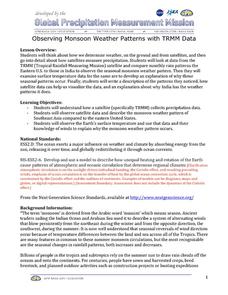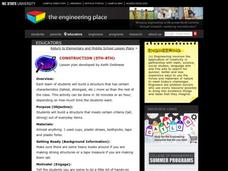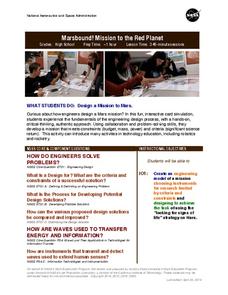Foundation for Water & Energy Education
How Can Work Be Done with Water Power? Activity C
Third in a set of lessons regarding reservoirs, dams, and hydropower, this involves a two-day hydropower plant simulation. Collaborative groups build, maintain, and finance the plant. The transparency of the reservoir setup can be...
Texas State Energy Conservation Office
Investigation: Building a Parabolic-Trough Collector
Amateurs of alternative energy build a mini parabolic-trough solar energy collector and use it to heat water. Temperature is recorded over a three-minute period and the data is graphed and analyzed. Note that in order to paint aquarium...
NASA
Observing Monsoon Weather Patterns with TRMM Data
Follow a fabulous slide show on how monsoons form and how satellite technology is being used to observe the phenomena, explaining why they occur. Afterward, visit the TRMM (Tropical Rainfall Measuring Mission) website to access actual...
National Science Teachers Association
Paper Car Crash Design
High school physical scientists collide with motion. They work in pairs to design a paper car that will protect a raw egg during a head-on collision. Measurements of distance traveled, time of run, vehicle specs, and photo gate flags are...
North Carolina State University
Construction
Engineering design projects serve as great opportunities for collaborative problem solving. In this case, learners work in small groups designing, building, and eventually testing a structure that meets a teacher-specified objective. It...
NASA
Marsbound! Mission to the Red Planet
It's time to go to Mars. Using the provided cards and mat, groups design a mission to Mars. The cards contain information about the different components of the launch and warn about a few mishaps that might occur along the way.
Curated OER
Asexual Propagation
Grow plants from the ones you already have. Explore plant-cutting techniques through this detailed guide covering herbaceous, soft-wood, and semi-hardwood species. Ideal to use with a higher-ed or vocational class. Tip: Invite students...
Curated OER
Parts of the Plants that we Eat
First graders study plants and their parts to see what parts are edible. In this plant lesson students are assigned plant parts and they are to put them in the right category.
Curated OER
Introduction to Plant Science
Although the formatting is less than perfect and some of the pictures are blurry, the information in this presentation on plants is pertinent. Viewers will be able to compare and contrast plants with animals. They will learn about...
Curated OER
Lesson 2 - Design Process-Measuring Wind Speed
A terrific activity focused on the design process. It begins with a presentation, "Design: Solve a Problem," which lists the steps of the process and then introduces the specific challenge: to build a device that measures wind speed....
Curated OER
Blushing Pumpkins
Young scholars explore the changing seasons, and how the weather affects plant in various regions. They examine a pumpkin utilizing their touch, sight and smelling senses. They draw a large chalk pumpkin with a stem. They color their...
Curated OER
Latin: Fifth Declension Nouns
Also known as -e stem nouns, the fifth declension nouns in Latin almost all end in ies. Have scholars use this chart to identify the nominative and genitive form for different nouns you provide.
Curated OER
Statistics: Standard Deviation and Outliers
In this statistics learning exercise, statisticians construct a stem-plot and answer questions regarding the shape of the distribution, standard deviation, and outliers.
Texas State Energy Conservation Office
Power Systems & Efficiency
Are you looking for a reading resource about the efficiency of power systems? Here is one that introduces the output/input ratio, measurement of energy by joules or calories, and efficiency ratings. For STEM classes that are learning...
Curated OER
Cause and Effect: Nationalist Revolution in China
This graphic organizer gives the class four boxes to fill in. Each box is to house causes and effects for long and short-term that stemmed from the Nationalist Revolution in China. Tip: Place this worksheet under the document camera and...
Curated OER
Writing Lowercase k and f
Here's some visual printing practice with lowercase letters k and f. Emerging writers trace each letter before trying a few freehand in the space provided. Note that there is no dotted middle line here to keep your printers on track as...
Curated OER
This is Cool!
Third and fourth graders who are studying states of matter will enjoy this simple exercise. In it, they look at a picture of a girl in her kitchen, and they must circle five examples of materials that have changed states of matter as...
Institute for Systems Biology
Introduction to Saline Environments & Microbial Halophiles
If you do not mind wading through unrelated headings (This is not for a physics or STEM course, as it states.) and content (The lesson opens with an article about neurology, not halophiles.), then you will find a valuable resource on...
Discovery Education
It's Too Loud!
STEM scholars investigate sound attenuation by conducting an experiment in which they compare the farthest distance that they can hear a sound with and without ear protection.
Curated OER
Clover Chain
Students take two clovers tieing one clover's stem at the top of the other clover's stem. In this art lesson, students repeat this making a chain or necklace.
Curated OER
Drops on a Penny
Eighth graders experiment to determine the number of drops of water a heads up penny hold. They create a stem and leaf graph of the class results and use the data for further experimentation on a tails up penny.
Curated OER
Tops and Bottoms
First graders classify vegetables by which parts are edible. In this plant biology lesson, 1st graders are read Tops and Bottoms by Janet Stevens, participate in a discussion of which plant parts are edible in the story, then sort real...
Curated OER
Ten Acorns
In this following written directions worksheet, learners read directions and perform the instructions of numbering acorns clockwise 1 to 10, coloring coding the stems even and odd numbers, and color numbered acorns different colors....
Curated OER
Plot It
Students use a stem-and-leaf plot from a set of data to identify the range, median, and mode of their own math grades.
Other popular searches
- Stem and Leaf Plots
- Stem Cells
- Stem and Leaf
- Brain Stem
- Stem Cell Research
- Roots, Stems and Leaves
- Stem and Leaf Plots
- Roots Stems and Leaves
- Cell Biology Stem Cells
- Plant Stems
- Flower Stems
- Human Stem Cells

























